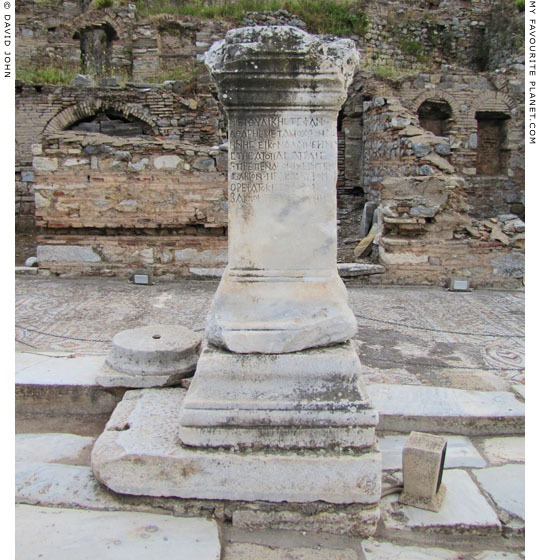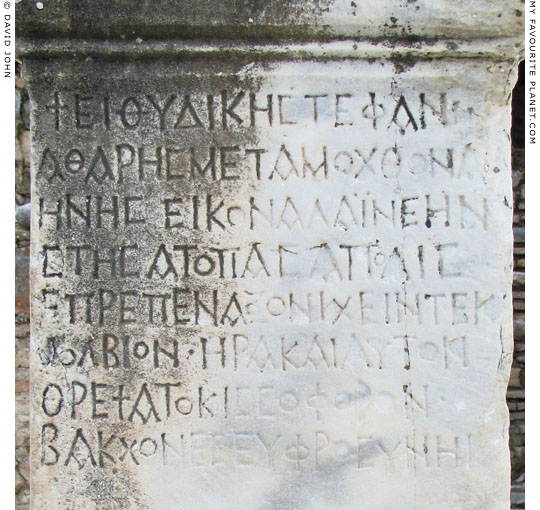|
|
|
| My Favourite Planet > English > Middle East > Turkey > Selçuk > photo gallery 2 |
| Selçuk gallery 2 |
Ephesus Museum, Selçuk |
 |
 |
8 of 10 |
 |
 |
|
| |
|
Statue of Proconsul Stephanos, Ephesus Archaeological Museum, Selçuk. |
| |
For further details about the Ephesus Archaeological Museum,
including opening times, see page 4: sightseeing in Selçuk. |
| |
According to the museum's labelling, this marble statue of Proconsul Stephanos is dated to the 6th century AD. It was found in 1923 with its inscribed statue base (see photos below) at the lower end of the Kuretes Street in Ephesus, near the Baths of Scholastikia. The base now stands near the find spot, outside the late antique "Alytarch's Stoa" (4th - 5th century AD). The body of the statue is older than the portrait head, which may have been sculpted in 6th century AD, during the reign of Emperor Justinian.
Little is known about Stephanos (Στεφάνος), however, from the inscription on the statue pedestal (see below) it appears he was from the Greek island of Naxos in the Cyclades. We also learn that he was a judge or games official in Ephesus. His garments, a tunic and toga, and the fact that he holds a sceptre in his left hand and raises a mappa [1] in the right, indicate that he was a proconsul of Asia. In the Roman Empire, proconsuls were appointed for one year as governors of provinces, though by Byzantine times they often served longer, and by the end of the 6th century AD the office ceased to exist.
It has been suggested that he may have been the same Stephanos mentioned in an inscription on the facade of the Library of Celsus as having converted the building into a nympheum (monumental fountain). [2] The library was destroyed either by an earthquake or the Goths during the 3rd century AD, and apparently thereafter never restored. However, since other scholars believe that the nympheum was constructed around 400 AD, this would make it too early for the proconsul. Stephanos was a common name, and the inscription may be referring to the architect of the nympheum rather than its sponsor.
Inv. No. 1402.
Statue height 202 cm. |
|
| |

The pedestal of the statue of Proconsul Stephanos outside the late antique
"Alytarch's Stoa" (4th-5th century AD) on Kuretes Street, Ephesus. |
| |

Greek honorific inscription in elegiacs on the pedestal of the
statue of Proconsul Stephanos set up by the polis (city).
☩ εἰθυδίκῃ Στεφάνῳ κ-
αθαρῆς μετὰ μόχθον ἀ-
ήνης εἰκόνα λαϊνέην
στήσατο πᾶσα πόλις·
ἔπρεπε Νάξον <ἔ>χειν τέκος
ὄλβιον, ἥ ῥα καὶ αὐτὸν
θρέψατο κισσοφόρον
Βάκχον ἐς εὐφροσύνην.
"☩ The whole city set up a stone statue to Stephanos,
who judges fairly, after the pure labour of his service.
It is fitting for Naxos to have such a fortunate offspring,
since she nourished ivy-bearing Bacchus for joy."
Inscription Ephesos 3073 (Inschriften von Ephesos (IvE) 1310)
at The Packard Humanities Institute.
Despite the poetic reference to Bacchus (a.k.a. Dionysus, the Greek god
of wine and revelry), the cross at the start of the inscription identifies it
as a product of the Christian era. For further information about the
connection between Dionysus and the island of Naxos, see the mosaic
of Dionysus and Ariadne on Naxos on gallery page 2. |
|
| |
| |
Ephesus
Museum
Selçuk |
Notes, references and links |
 |
|
1. Mappa
A mappa was a cloth napkin, often made of linen, used by the Romans for wiping their hands while dining. It was known to the Greeks as xeiromaktron (χειρόμακτρον) or ekmageion (ἐκμαγεῖον). It became usual for wealthy people to carry a mappa as an ornament and status symbol. An emperor, consul or magistrate would raise then drop his mappa to signal the start of games or a race. In the iconography of the late Roman Empire it became a principal attribute of consuls.
See the entry Mappa, in William Smith, A Dictionary of Greek and Roman Antiquities. John Murray, London. 1890. At Perseus Digital Library.
2. Another honorific inscription for proconsul Stephenos, set by the boule, was found by Austrian archaeologists in Ephesus in 1981-1982.
ἡ βουλὴ Στέφανον
πτολίων κλυτὸν
ἡνιοχῆα ὃς θρόνον
ἀνθυπάτων ἔλαχεν
καὶ χωρὸν ὑπάρχων
Inscription Ephesos 3074 at The Packard Humanities Institute.
See: Jahreshefte des Österreichischen Archäologischen Institutes Band 53 (1981-1982), page 142, No. 150. |
|
|
Map, photos and articles: © David John,
except where otherwise specified.
Additional photos: © Konstanze Gundudis
All photos and articles are copyright protected.
Images and materials by other authors
have been attributed where applicable.
Please do not use these photos or articles without permission.
If you are interested in using any of the photos for your
website, project or publication, please get in contact.
Higher resolution versions are available on request. |
|
| |
 |
Visit the My Favourite Planet Group on Facebook.
Join the group, write a message or comment,
post photos and videos, start a discussion... |
|
|
| |
|
|
|